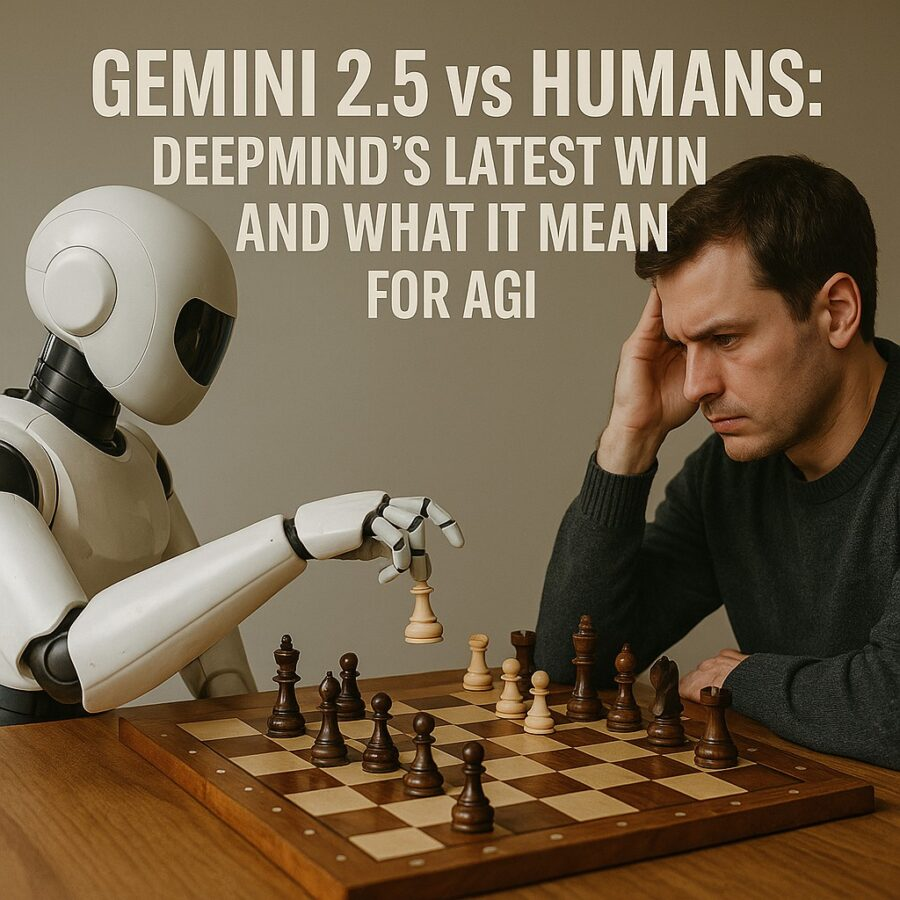Views: 3
If you care about where artificial intelligence is heading, you woke up to a different landscape this year. The headline that turned heads was simple: Gemini 2.5 vs Humans is no longer a hypothetical debate. In a high-stakes test that rewards raw reasoning, speed, and ingenuity, Google DeepMind’s newest system delivered a result that would have sounded far-fetched just a short time ago.
It performed at a gold-medal level in the International Collegiate Programming Contest World Finals conditions, even cracking at least one problem no human team solved. That is not marketing spin. Multiple respected outlets documented the milestone, which also included a dominant showing from OpenAI. The scoreboard is changing, and the implications for AGI are serious. (Financial Times)
Below, we unpack what “DeepMind’s latest win” really is, why Gemini 2.5 vs Humans matters, how the model achieved it, and what it actually signals about progress toward artificial general intelligence.
The baseline: what Gemini 2.5 is supposed to be
Gemini 2.5 is Google DeepMind’s current flagship “thinking” family, a series designed to tackle complex reasoning, long-context analysis, and advanced code generation. The company positions 2.5 Pro as its best model for coding and highly complex prompts, complementing faster 2.5 Flash variants. DeepMind’s updates describe new features like improved long-context reasoning, stronger code tools, and an experimental “Deep Think” mode aimed at hard math and programming tasks. (blog.google)
On the developer side, Google showcases hands-on examples that highlight interactive simulations, data plotting, fractal generation, video understanding, and program synthesis from terse instructions. These demos align with the claim that the model can reason through multi-step plans before responding, which is crucial when tasks require decomposition rather than a single guess. (Google DeepMind)
The headline event: a gold-level result under ICPC conditions
Here is the story in plain terms. The ICPC World Finals is often called the “coding Olympics.” Teams of three students share a single computer for five hours and attempt twelve algorithmic problems that demand creativity, proof-style reasoning, and clean implementation. In tests run under those same constraints, OpenAI’s newest model topped the table, while DeepMind’s Gemini 2.5 achieved gold-medal level and solved at least one problem that no human solved. That is a concrete, external frame of reference, not a curated benchmark. (Financial Times)
Press coverage also noted Google’s own celebration of the feat, underscoring that senior leadership viewed it as a meaningful leap rather than a marketing footnote. (The Times of India)
Why this matters for Gemini 2.5 vs Humans: ICPC-style problems mix combinatorics, data structures, geometry, and number theory. They punish sloppy logic and reward stepwise decomposition, invariants, and constructive proofs. When an AI starts matching top human teams in that setting, you are not looking at a parlor trick. You are looking at transfer of general problem-solving skill in a compressed time window.
Beyond a single contest: how Gemini 2.5 performs on broader benchmarks
DeepMind’s public materials and model cards describe 2.5’s aims and evaluations: stronger code performance on LiveCodeBench and SWE-bench Verified, competence on math-heavy suites, and improved long-context tasks. The team also introduced Deep Think, an enhanced reasoning mode available to advanced users starting in mid-2025. These documents place the ICPC-style result in a broader pattern of progress on reasoning benchmarks and agentic tasks. (Google Cloud Storage)
Google’s product pages and blogs summarize competitive head-to-head results and price curves against contemporaries, while developer posts detail new multimodal abilities like video-to-animation pipelines. These sources show a model family maturing along three axes: code, reasoning, and multimodality. (Google DeepMind)
The key point for Gemini 2.5 vs Humans: the ICPC-style performance is consistent with the trendlines published by DeepMind. It is not an isolated spike.
Reality check: contest excellence is not the same as software engineering
Before we draw AGI conclusions, we need nuance. Analysts and reporters covering the “coding Olympics” result were careful to note that contest skills differ from day-to-day engineering. ICPC problems emphasize algorithmic inventiveness and clean implementation under pressure. Production software demands design documents, unit tests, refactoring, incremental complexity, coordination across teams, and months of maintenance. These are different environments. Still, a system that can handle the contest’s logic puzzles at gold level shows a transferable core of reasoning that matters for many real tasks. (Financial Times)
How Gemini 2.5 vs Humans became a live debate
Three factors converged.
- Improved internal planning. DeepMind frames 2.5 as a “thinking” model. The initiative to let the system reason through steps before responding reflects a broader industry shift toward deliberate inference. That choice shows up in stronger math and code outcomes. (Google DeepMind)
- Training data and evaluation discipline. The published reports and model cards indicate tighter links between training choices and external benchmarks, along with more transparent reporting of where numbers come from. That does not remove all uncertainty, but it signals maturity. (Google Cloud Storage)
- Agentic tooling and computer use. DeepMind announced progress on “computer use” capabilities that let models operate software and tools more reliably. That creates a path from contest-style reasoning to practical workflows. (blog.google)
Put these together and Gemini 2.5 vs Humans is not a gimmick. It is the visible edge of a deeper architectural and training strategy.
Where humans still hold advantages
Even with contest-level wins, humans keep several edges.
- Open-world judgment. Humans excel at reading messy contexts, navigating underspecified goals, and resolving conflicts of value.
- Long-horizon coordination. Teams design systems over quarters and years, adapting to shifting constraints, budgets, and stakeholders.
- Responsibility and trust. Humans own decisions, communicate intent, and accept accountability in ways an AI cannot.
These traits are not binary. They are gradients. As models gain tool use and longer memory, some gaps narrow. Yet for now, they remain significant in “from lab to product” environments.
The following is a referral or affiliated link that AltPenguin receives compensation for, should the link be used and the offer is completed. To provide full transparency, we at AltPenguin are stating this before you click the image below (the image will open a new page to the offer shown in the image).
What DeepMind’s latest win does tell us about AGI
AGI is a loaded term. A careful reading of Gemini 2.5 vs Humans suggests three grounded conclusions.
First, algorithmic generality is rising. The ICPC-style result indicates that the model can spot patterns, compose strategies, and implement solutions under time pressure. This is a proxy for general reasoning. It does not prove universal competence, but it suggests that the internal representations support abstraction and transfer. (Financial Times)
Second, multimodality plus code is a force multiplier. DeepMind’s own demos and writeups show the model moving fluidly among text, code, data, and video. Being able to extract structure from different media, then act via tools, points toward agentic skill that goes beyond pure text prediction. (Google DeepMind)
Third, evaluation is catching up to ambition. DeepMind’s reports and model cards emphasize named external sources for benchmarks, and they delineate where numbers come from. Better measurement does not guarantee safety, but it reduces confusion and hype. That is healthy for AGI discourse. (Google Cloud Storage)
Practical implications for teams adopting AI today
If you build products, the takeaway is pragmatic.
- Use models like Gemini 2.5 where algorithmic clarity exists. Contest-style strengths translate well to analytics, optimization, data structure manipulation, and program synthesis.
- Wrap models in guardrails and tests. Treat code outputs like junior engineer drafts. Run unit tests, fuzz tests, and formal checks.
- Exploit tool use. Let the model call compilers, linters, profilers, and external APIs. That bridges the gap between reasoning and reliable execution. (blog.google)
- Keep a human in the loop. Let people set goals, resolve ambiguity, and sign off on changes, especially in safety-critical domains.
This is the path from a compelling demo to robust, revenue-bearing systems.
The competitive picture: not a one-horse race
While this article centers on Gemini 2.5 vs Humans, the broader picture includes peers that also posted strong results under ICPC conditions. OpenAI reportedly solved all twelve tasks and would have taken first. DeepMind’s system landed at gold-medal level and uniquely cracked one problem no team solved. The presence of multiple contenders at this altitude suggests the field is coalescing around architectures and training strategies that deliver consistent high-end reasoning. That collective trend matters as much as any single lab’s win. (Financial Times)
The safety dimension: raising the bar as capabilities climb
As models approach and surpass elite human performance on more tasks, the cost of mistakes goes up. DeepMind’s materials describe safeguards and more explicit evaluations, but deployment is where safety is won or lost. Responsible teams should:
- Validate on out-of-distribution data before shipping.
- Run red-team exercises targeting prompt injection, tool abuse, and data exfiltration.
- Monitor for regressions and drift.
- Establish escalation paths when outputs drive real-world actions.
The better the model, the more tempting it is to skip these steps. Resist that temptation.
What this means for learners, researchers, and small businesses
Students and self-learners. Treat models like Gemini 2.5 as tireless coaches. Use them to modularize complex topics, propose solution outlines, and generate test cases. Then do the hard part yourself: verify, reflect, and revise.
Researchers. Lean into open, comparable evaluations. Contest-style external tests complement curated benchmarks and can reveal failure modes faster than synthetic suites.
Small businesses. Start narrow. Pick one process where algorithmic structure is clear. Build a workflow that pairs the model with tools you trust. Measure before and after. Scale once you see durable lift.
These are the everyday moves that convert headline wins into quiet compounding gains.
A note on forecasting: beyond code to human judgment
One might ask whether progress is limited to math and code. Recent coverage suggests competitive AI forecasters are beginning to place among strong human crowds on real-world questions, though top human generalists still lead. Hybrid human-AI workflows are already showing promise in judgment tasks. It is not the same as ICPC, but it points in the same direction: models are becoming useful partners in domains once considered off-limits. (The Guardian)
The following is a referral or affiliated link that AltPenguin receives compensation for, should the link be used and the offer is completed. To provide full transparency, we at AltPenguin are stating this before you click the image below (the image will open a new page to the offer shown in the image).
Where Gemini 2.5 vs Humans goes next
The likely near-term frontier includes four tracks.
- Long-horizon coding. Moving from contest programs to month-scale refactors that preserve behavior across large codebases.
- Agentic computer use. Turning natural instructions into multi-step tool sequences with reliable recovery from errors. (blog.google)
- Robust multimodality. Reading, reasoning about, and acting on mixed video, audio, and text streams in real time. (Google Developers Blog)
- Transparent evaluation. Continued publication of model cards and reports with clear data sources and apples-to-apples comparisons. (Google Cloud Storage)
Each track reduces a different gap between demo and durable capability.
So, is this AGI?
AGI means different things to different people. A cautious position is this: when a system can repeatedly match or exceed top human performance across diverse, novel tasks with minimal supervision, and can generalize those skills to operate tools and pursue goals over time, you are in AGI territory.
By that yardstick, Gemini 2.5 vs Humans marks clear forward motion. The ICPC-style gold-level showing under contest conditions is one brick in the wall. The broader benchmark gains and tool-use advances add more bricks. We are not at a universal, autonomous generalist that can own complex projects end-to-end without oversight. But the curve is bending.
Bottom line for builders and readers
- The new result is legitimate and externally legible. It is not a cherry-picked dataset. (Financial Times)
- Gemini 2.5’s capabilities line up with its published design goals. Code, reasoning, and multimodality are improving together. (Google DeepMind)
- Contest wins do not erase the need for engineering discipline. They do make full-stack, AI-accelerated development more credible. (Venturebeat)
- The path to AGI looks less like a singular moment and more like a series of overlapping thresholds. This is one of them.
The debate is not whether AI can do impressive things in clean lab settings. The debate is whether those skills hold when the clock is running, the stakes are real, and the problems are new. With Gemini 2.5 vs Humans, the answer in at least one demanding arena is yes.
The following is a referral or affiliated link that AltPenguin receives compensation for, should the link be used and the offer is completed. To provide full transparency, we at AltPenguin are stating this before you click the image below (the image will open a new page to the offer shown in the image).
Sources and further reading
- Financial Times on gold-level ICPC performance under contest conditions, including a unique problem solved by DeepMind’s system. (Financial Times)
- Times of India highlighting Google leadership’s remarks on the achievement. (The Times of India)
- Google DeepMind announcements on Gemini 2.5, Deep Think, and developer-focused capabilities. (blog.google)
- Developer blog on video understanding and creative multimodality in 2.5. (Google Developers Blog)
- Model documentation and reports detailing evaluation scope and benchmark sources. (Google Cloud Storage)
- Coverage of AI progress in human forecasting contests for broader context beyond coding. (The Guardian)





